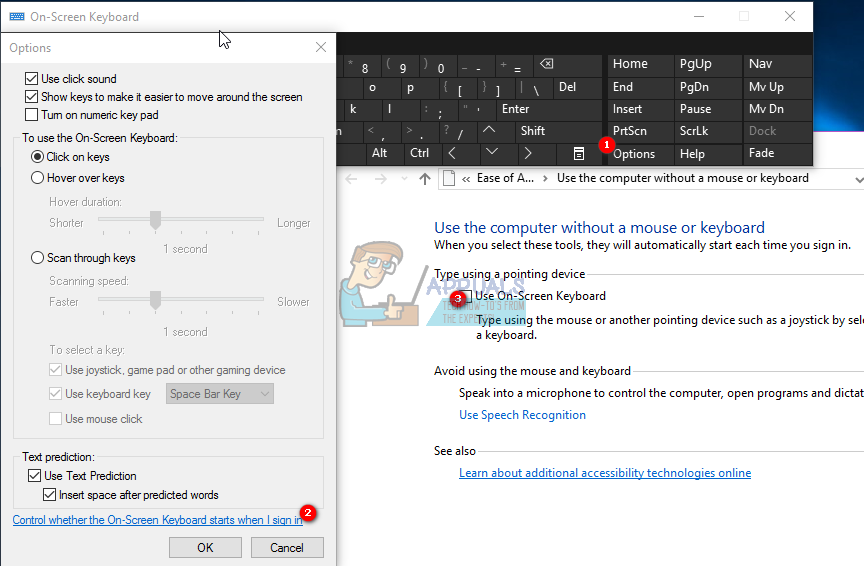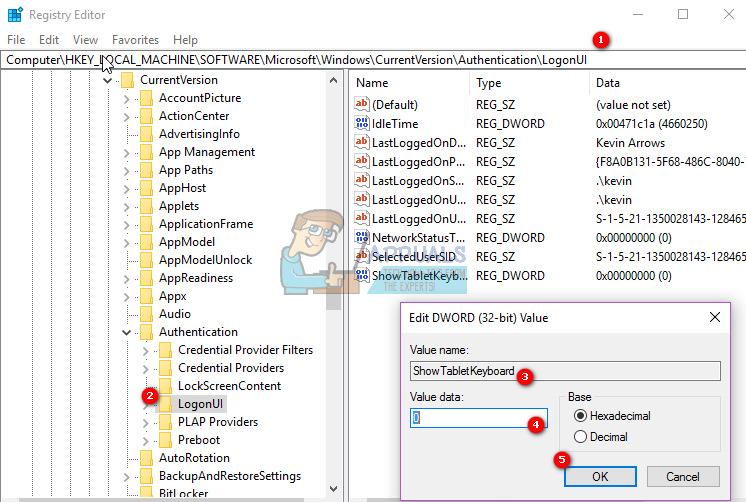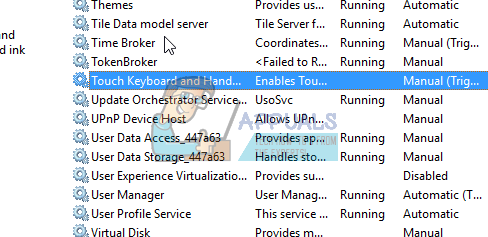Fix: Disable Windows 10 On Screen Keyboard
Windows 10 is a light weight operating system that has been designed for computers and smartphones. Borrowing features from its predecessors, windows 10 seeks to create the perfect balance between a standard computer and a touchscreen computer. With these in mind, several programmers have taken the advantage of the touchscreen feature and incorporated it in their programs.
As a feature of ease of access or for people that have a difficulty typing on their standard keyboard, windows 10 provides an On Screen Keyboard. You can click on the buttons to type, or if you have a touchscreen, you can tap on the keys to type. Complaints have however sparked from users concerning the unsolicited appearance of the On-Screen Keyboard. The keyboard always turns on whenever you go to the login screen. That means, whenever you log out or start your PC, the on-screen keyboard will always come on.

This article will explain why the on-screen keyboard will suddenly start appearing on login and guide you on how you can remedy the situation.
Reasons why the on-screen keyboard appears
So what could make the annoying on-screen keyboard to appear at login? Here are a few reasons.
Windows 10 gives developers the ability to invoke the on-screen keyboard and the touchscreen mode. There are therefore several such applications that can open the on-screen keyboard. If such a program is listed in the start up programs, then every time you boot your computer, the program will load to the system and load the on-screen keyboard along with it.
The other reason is quite simple and straight forward. You probably set up your on-screen keyboard to open on the login window. You might have done this unknowingly via an application. These settings can be found in the ease of access center.
Here is how to stop the on-screen keyboard from opening on start up or whenever you go to the login screen.
Method 1: Disable on-screen keyboard from the ease of access centre
- Press Windows/Start Key + U to open the ease of access centre.
- Under “keyboard“
- Slide the “Use On-Screen Keyboard” to off.

Method 2: Disable on-screen keyboard from the on-screen keyboard options
The on-screen keyboard provides options to change its settings, and included in that is a shortcut to disable it from starting in the login screen.
- Press Windows/Start Key + R to open “Run” and type in “osk” then press the “Enter” key. This will start the on-screen keyboard.
- At the bottom of the keyboard to your right you will see a key “Options”, click on that key.
- You will get a popup “Options” box and at the bottom you will see a blue link “Control whether the On-Screen Keyboard starts when I sign in.” Click on that link and another box will popup.
- If “Use On-Screen Keyboard” is checked, uncheck it!
- Select “Apply” then “OK” to save changes and close the window
- Select “OK” on the “Options” box to close it out. “Ease of Access Center” window may be visible, just close it.
- Close the on-screen Keyboard.

Method 3: Disable on-screen keyboard from showing on the login screen via the registry editor
- Hold down the Windows/Start Key and press “R” to bring up the “Run” dialog.
- Type “regedit“, then press “Enter“.
- Navigate to the following location:HKLM (HKEY_LOCAL_MACHINE) -> SOFTWARE -> Microsoft -> Windows -> CurrentVersion -> Authentication -> LogonUI
- Open “ShowTabletKeyboard” by double clicking on it.
- Set the value data to “0” to disable it. If this key doesn’t exist, you can create it.

Method 4: Disable the Touch screen keyboard and handwriting panel service
This will stop the on-screen keyboard service from starting. This will stop the keyboard from popping up because the service will not be available to be invoked by applications.
- Hold down the Windows/Start Key and press “R” to bring up the “Run” dialog.
- Type “services.msc“, then press “Enter“.
- Scroll down to “Touch screen keyboard and handwriting panel”
- Right click and select “stop”
- Right click again, and select “properties”
- From the general tab in the properties window, Change the startup type setting from “automatic” to “disabled”.
- You might have to restart your PC if prompted.

If an error occurs at start up due to this broken service, you can reenable it the same way and select “automatic” in the startup type setting.
Method 5: Use command prompt commands to disable on-screen keyboard on login
You can use the command prompt to speed up the process of disabling the on-screen keyboard service.
- Click Start, and then type cmd in the Start Search box. (Don’t use run since it won’t allow you to run as an administrator.
- In the search results list, right-click Command Prompt or CMD, and then click Run as Administrator.
- In the command prompt window, type or copy-paste this command and hit enter:
sc config “TabletInputService” start= disabled - Now type or copy paste this command and press enter:
sc stop “TabletInputService” - This will stop the service that was already running.
- To re-enable the service, user the commands:
sc config “TabletInputService” start= autosc start “TabletInputService”

Method 6: Stop windows 10 apps from starting apps that open the on-screen keyboard on start up
In some cases a windows app that needs the touchscreen keyboard will start the on-screen keyboard on start up. If your problem persists, you will need to take these steps to disable it:
Think about the apps you’ve recently installed, and if one of them might have caused your computer to think it has a touch screen, or need ease of access features. Uninstall it, and restart your computer to see if the problem goes away.
- Hold down the Windows/Start Key and press “R” to bring up the “Run” dialog.
- Type “appwiz.cpl“, then press “Enter“.
- Double click on any program you want to uninstall
Alternatively, you can open Task Manager by pressing Ctrl + Shift + Esc on your keyboard, and go to the Startup tab. Try disabling certain startup tasks that you suspect start the on-screen keyboard here to see if it solves the problem.





